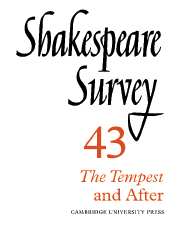Book contents
- Frontmatter
- The Power of Magic: From Endimion to The Tempest
- Reading The Tempest
- The Latter End of Prospero’s Commonwealth
- Henry VIII and the Deconstruction of History
- The Politics of Conscience in All is True (or Henry VIII)
- Shakespeare’s Romantic Innocents and the Misappropriation of the Romance Past: The Case of The Two Noble Kinsmen
- The Hand of John Fletcher in Double Falsehood
- ‘The Duke my Father’s Wrack’: The Innocence of the Restoration Tempest
- ‘Remember/First to Possess his Books’: The Appropriation of The Tempest 1700-1800
- The Tempest and After
- Poetry’s Sea-Changes: T. S. Eliot and The Tempest
- The New Function of Language in Shakespeare’s Pericles: Oath versus ‘Holy Word’
- The Discovery of The Rose Theatre: Some Implications
- The Origins of the Roxana and Messallina Illustrations
- Recycling the Early Histories: ‘The Wars of the Roses’ and ‘The Plantagenets’
- Shakespeare Production in England in 1989
- Professional Shakespeare Productions in the British Isles, January-December 1988
- The Year's Contributions to Shakespeare Studies: 1 Critical Studies
- 2 Shakespeare’s Life, Times, and Stage
- 3 Editions and Textual Studies
- Books Received
- Index
2 - Shakespeare’s Life, Times, and Stage
Published online by Cambridge University Press: 28 March 2007
- Frontmatter
- The Power of Magic: From Endimion to The Tempest
- Reading The Tempest
- The Latter End of Prospero’s Commonwealth
- Henry VIII and the Deconstruction of History
- The Politics of Conscience in All is True (or Henry VIII)
- Shakespeare’s Romantic Innocents and the Misappropriation of the Romance Past: The Case of The Two Noble Kinsmen
- The Hand of John Fletcher in Double Falsehood
- ‘The Duke my Father’s Wrack’: The Innocence of the Restoration Tempest
- ‘Remember/First to Possess his Books’: The Appropriation of The Tempest 1700-1800
- The Tempest and After
- Poetry’s Sea-Changes: T. S. Eliot and The Tempest
- The New Function of Language in Shakespeare’s Pericles: Oath versus ‘Holy Word’
- The Discovery of The Rose Theatre: Some Implications
- The Origins of the Roxana and Messallina Illustrations
- Recycling the Early Histories: ‘The Wars of the Roses’ and ‘The Plantagenets’
- Shakespeare Production in England in 1989
- Professional Shakespeare Productions in the British Isles, January-December 1988
- The Year's Contributions to Shakespeare Studies: 1 Critical Studies
- 2 Shakespeare’s Life, Times, and Stage
- 3 Editions and Textual Studies
- Books Received
- Index
Summary
In a year in which the remains of the Rose and now, as it seems, of ‘the great Globe itself’ have been restored to view, and their status in our heritage has exercised the leader writers of the national press, it is appropriate to start with the theatres Shakespeare himself knew and used, and their status in his own day. John Orrell, the author of two distinguished books, The Quest for the Globe and The Theatres of Inigo Jones and John Webb, has now produced The Human Stage: English Theatre Design, 1567–1640. This is not merely a synthesis of his earlier work, though inevitably it covers some of the same territory. It is, rather, an attempt to find a coherent thread and purpose running through the theatre-design of the whole period. Contemplating a bird’s-eye view of London c. 1600, he observes: ‘Save for the great churches, no other class of building in the prospect [than the theatres] announces with such certainty that it is shaped by an idea transcending the utilitarian, or bears so closely the imprint of the human spirit’ (p. 4). He adroitly undermines the claims for the two most commonly advanced utilitarian 'models' for the Theatre and its successors, the inn-yards (where he looks closely at the Red Lion and the Boar's Head) and the animal-baiting rings, before advancing his own thesis: The theatre design in the Second Book [of Serlio's Architettura] was enormously influential in England, especially through its readily imitable scenic constructions, but also through its auditorium planning ... It governed the design of many of the Court theatres of Inigo Jones . . . and there is . . . some reason for believing that it helped to shape even the commercial playhouses, both public and private, of Elizabethan and Jacobean London' (P- H9).
- Type
- Chapter
- Information
- Shakespeare Survey , pp. 235 - 254Publisher: Cambridge University PressPrint publication year: 1991



